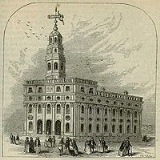
Nauvoo Temple
Encyclopedia
The Nauvoo Temple was the second temple constructed by the Church of Jesus Christ of Latter Day Saints, commonly known as the Mormon
s. The church's first temple
was completed in Kirtland, Ohio
, United States
in 1836. When the main body of the church was forced out of Nauvoo, Illinois
in the winter of 1846, the church attempted to sell the building, finally succeeding in 1848 . The building was damaged by fire and a tornado before being demolished.
In 1937, The Church of Jesus Christ of Latter-day Saints reacquired the lot on which the original temple had stood. The Church built a temple on the original site whose exterior is a replica of the first temple, but whose interior is laid out like a modern Latter-day Saint temple
. On 27 June 2002, this new temple was dedicated as the Nauvoo Illinois Temple
.
 The Latter-day Saints made preparations to build a temple soon after establishing their headquarters at Nauvoo, Illinois
The Latter-day Saints made preparations to build a temple soon after establishing their headquarters at Nauvoo, Illinois
in 1839. On 6 April 1841, the temple's cornerstone was laid under the direction of Joseph Smith, Jr., the church's restorer. Sidney Rigdon
gave the principal oration. At its base the building was 128 feet (39 m) long and 88 feet (26.8 m) wide with a clock tower
and weather vane
reaching to a total height of 165 feet (50.3 m)—a 60% increase over the dimensions of the Kirtland Temple. Like Kirtland, the Nauvoo Temple contained two assembly halls, one on the first floor and one on the second, called the lower and upper courts. Both had classrooms and offices in the attic. Unlike Kirtland, the Nauvoo Temple had a full basement which housed a baptismal font. Because the Saints had to abandon Nauvoo, the building was not entirely completed. The basement with its font was finished, as were the first floor assembly hall and the attic. When these parts of the building were completed they were used for performing ordinances (basement and attic) or for worship services (first floor assembly hall).
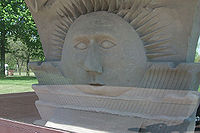 The Nauvoo Temple was designed in the Greek Revival style by Mormon architect William Weeks
The Nauvoo Temple was designed in the Greek Revival style by Mormon architect William Weeks
, under the direction of Smith. Weeks' design made use of distinctively Latter-day Saint motifs, including Sunstones, Moonstones, and Starstones. It is often mistakenly thought that these stones represent the Three Degrees of Glory
in the Mormon conception of the afterlife, but the stones appear in the wrong order. Instead, Wandle Mace, foreman for the framework of the Nauvoo Temple, has explained that the design of the temple was meant to be “a representation of the Church, the Bride, the Lamb’s wife” (Wandle Mace, Autobiography 207 (BYU Special Collections)). In this regard Mace references John’s statement in Revelation 12:1 concerning the “woman clothed with the sun, and the moon under her feet, and upon her head a crown of twelve stars.” This explains why the Starstones are at the top of the temple (“crown of twelve stars”), the Sunstones in the middle (“clothed with the sun”) and the Moonstones at the bottom (“moon under her feet”).
Construction was only half complete when Smith was assassinated in 1844. After a succession crisis
, Brigham Young
was sustained as the church's leader by the majority of Mormons in Nauvoo. As mob violence increased during the summer of 1845, he encouraged the Latter-day Saints to complete the temple even as they prepared to abandon the city. Young likely altered the original plans to add a large pediment
beneath the cupola
. Even as the temple was under construction portions of it were used for sacred rites, such as baptisms for the dead
in the basement font. During the winter of 1845-46, the temple began to be used for additional ordinances, including the Nauvoo-era rituals of Endowment
and Sealings in Marriage and Adoptions
. The Nauvoo Temple was in use for less than three months.
Most of the Latter-day Saints left Nauvoo, beginning in February 1846, but a small crew remained to finish the temple's first floor, so that it could be formally dedicated. Once the first floor was finished with pulpits and benches, the building was finally dedicated in private services on 30 April 1846, and in public services on 1 May. In September 1846 the remaining Mormons were driven from the city and vigilantes from the neighboring region, including Carthage, Illinois
, entered the near-empty city and vandalized the temple.
.jpg) Initially the church's agents tried to lease the structure, first to the Catholic Church, and then to private individuals. When this failed, they attempted to sell the temple, asking up to $200,000, but this effort also met with no success. On 11 March 1848, the church's agents sold the building to another Mormon, David T. LeBaron, for $5,000.http://findarticles.com/p/articles/mi_qa3945/is_200210/ai_n9117230/pg_22 Finally, the New York Home Missionary Society expressed interested in leasing the building as a school, but around midnight on 8–9 October 1848, the temple was set on fire. http://findarticles.com/p/articles/mi_qa3945/is_200210/ai_n9117230/pg_12 http://deseretbook.com/nauvoo/timeline http://books.google.com/books?id=Lu-xKGcXQV4C&pg=PA35&lpg=PA35&dq=nauvoo+temple+fire+october+9+1848&source=web&ots=YsN5C2gp6g&sig=Dwzsg5LgQPDJRjJkdxAhwA3JmDQhttp://www.strangite.org/Temple.htm Nauvoo's residents — mostly non-Mormons and the few Mormons remaining in Nauvoo — vainly attempted to put out the fire, but the temple was gutted. James J. Strang, leader of a rival faction
Initially the church's agents tried to lease the structure, first to the Catholic Church, and then to private individuals. When this failed, they attempted to sell the temple, asking up to $200,000, but this effort also met with no success. On 11 March 1848, the church's agents sold the building to another Mormon, David T. LeBaron, for $5,000.http://findarticles.com/p/articles/mi_qa3945/is_200210/ai_n9117230/pg_22 Finally, the New York Home Missionary Society expressed interested in leasing the building as a school, but around midnight on 8–9 October 1848, the temple was set on fire. http://findarticles.com/p/articles/mi_qa3945/is_200210/ai_n9117230/pg_12 http://deseretbook.com/nauvoo/timeline http://books.google.com/books?id=Lu-xKGcXQV4C&pg=PA35&lpg=PA35&dq=nauvoo+temple+fire+october+9+1848&source=web&ots=YsN5C2gp6g&sig=Dwzsg5LgQPDJRjJkdxAhwA3JmDQhttp://www.strangite.org/Temple.htm Nauvoo's residents — mostly non-Mormons and the few Mormons remaining in Nauvoo — vainly attempted to put out the fire, but the temple was gutted. James J. Strang, leader of a rival faction
of Latter Day Saints, accused Young's agents of setting fire to the temple; however, these charges were never proven. On 2 April 1849 LeBaron sold the damaged temple to Étienne Cabet
for $2000. Cabet, whose followers were called Icarians
, hoped to establish Nauvoo as a communistic
utopia
.
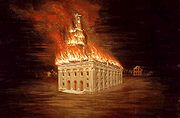 On 27 May 1850, the temple was struck by a tornado which toppled one wall, and Cabet ordered the demolition of two more walls in the interests of public safety, leaving only the façade standing. The Icarians used much of the temple's stone to build a new school building on the southwest corner of the temple lot. By 1857, however, most of Cabet's followers had left Nauvoo and over time many of the original stones for the temple were used in the construction of other buildings throughout Hancock County
On 27 May 1850, the temple was struck by a tornado which toppled one wall, and Cabet ordered the demolition of two more walls in the interests of public safety, leaving only the façade standing. The Icarians used much of the temple's stone to build a new school building on the southwest corner of the temple lot. By 1857, however, most of Cabet's followers had left Nauvoo and over time many of the original stones for the temple were used in the construction of other buildings throughout Hancock County
. In February 1865 Nauvoo's City Council ordered the final demolition of the last standing portion of the temple—one lone corner of the façade. Soon afterwards, all evidence of the temple disappeared, except for a hand pump over a well that supplied water to the font. Three of the original sunstones are known to have survived and are on display — one is on loan to The Church of Jesus Christ of Latter-day Saints' Visitor Center in Nauvoo, one is in the Smithsonian Institution
in Washington, D.C, and the third and only one that has not been restored is displayed, along with the only moonstone on display, at the Joseph Smith Historic Center (Community of Christ
).
 Between 1937 and 1962, The Church of Jesus Christ of Latter-day Saints reacquired the lot on which the temple stood. In 1999 church president Gordon B. Hinckley
Between 1937 and 1962, The Church of Jesus Christ of Latter-day Saints reacquired the lot on which the temple stood. In 1999 church president Gordon B. Hinckley
announced the rebuilding of the temple on its original footprint. After two years of construction, on 27 June 2002, the church dedicated the new temple
, whose exterior is a replica of the first temple, but whose interior is laid out like a modern Latter-day Saint temple
.
was built 60% larger in dimensions than its predecessor, the Kirtland Temple. Like Kirtland, the temple contained two assembly halls, one on the first floor and one on the second, called the lower and upper courts. Both had classrooms and offices in the attic. Unlike Kirtland
, it had a full basement which housed a baptismal font.
, quarried from a site just west of the temple.
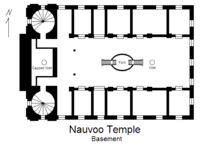 The basement of the Nauvoo Temple was used as the baptistry, containing a large baptismal font
The basement of the Nauvoo Temple was used as the baptistry, containing a large baptismal font
in the center of the main room.
The basement was reached from the spiral staircases at the Northwest and Northeast corners of the temple. The staircase landing was made of wood and opened to a short hallway heading East, leading to the basement proper. Between the two hallways was an unfinished room sealed off from the rest of the temple, containing an old well that had been dug but never used. The room was discovered by an anti-Mormon mob who broke through the floor of the vestibule above.
The basement proper was one hundred feet long and forty feet wide with six rooms of varying sized on either side. The sides of the rooms were stone and abutted the massive stone piers that supported the floors above. With the exception of the two rooms at the West end of the basement, reportedly used for clerical purposes, each side room rose two steps in height from the basement floor. The rooms were dressing rooms for those using the font. The floor was made of red brick laid in a herringbone pattern. The walls were painted white. The floor sloped down to the center of the room to allow water to run toward a drain beneath the font.
During an archaeological investigation of the temple site, two highly polished limestone blocks were discovered.
Approximately twelve feet east of the entrance to the baptistry and ten feet from either the side of the support piers rested the blocks, roughly fourteen inches square, which projected seven inches (178 mm) above the brick floor. These objects are not mentioned in any account of the basement, and their purpose is unknown. They may have held some type of support columns, dividing the font from the entrance to the basement or they may have simply been a decorative element with a vase or something similar resting on them. They may have been part of a feature planned, but not used, in the final construction.
The first font was built out of tongue and groove
d white pine and painted white. It was sixteen feet long, twelve feet wide and four feet deep. The lip of the font was seven feet from the floor. The font's cap and base were carved molding in an "antique style" and the sides were finished with panel work. Two railed stairways led to the font from the north and south sides.
The font was held up by twelve oxen as are all Latter-day Saint temple fonts. They were carved from pine planking that was glued together. They were patterned from the most beautiful five-year old steer that could be found in the region. The head, shoulders and legs protruded beyond the base of the font, and they appeared to have sunk to their knees into the pavement. The most perfect horn that could be found was used to model the animals horns.
A decision was made to replace the wooden font in 1845, apparently because the water caused a mildew odor, and possibly because the wood began to rot. The new limestone font followed the pattern of the wooden one. Twelve oxen held up the basin, four on each side and two at each end. The oxen were solid stone and similarly were placed and appeared sunken into the floor. Where the oxen met the basin, the stone was carved to suggest drapery. The ears of the oxen were made of tin. The stairs were moved to an East/West orientation making access to the font easier.
A well on the east side of the font provided the water supply. There may have been some kind of tank at the East end of the baptistry to store and heat water.
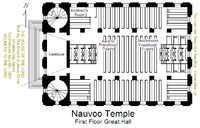 A flight of eight broad steps led to a landing where two more steps entered three archways. These archways led to the vestibule, the formal entrance to the temple.
A flight of eight broad steps led to a landing where two more steps entered three archways. These archways led to the vestibule, the formal entrance to the temple.
The archways were approximately nine feet wide and twenty-one feet high.
The vestibule itself was forty-three feet by seventeen feet in dimension. It was composed of limestone on all four of its walls. The floor has been speculated to be made of wood, because when the mob occupied the temple briefly in late 1847, they broke through the floor to reach a sealed off room in the basement. Had the floor been limestone, it seems unlikely that they would have dug it up.
Two large double doors on the east wall opened to the first floor assembly hall of the lower court, known as the "Great Hall". Two doors, one on the North wall, and another on the South opened to the landing of two spiral staircases, one in the Northwest corner, and the other in the Southwest corner which led all the way to the attic. These were the only access points to the rest of the building.
One report stated that on the east wall of the vestibule was an entablature, similar to the one in the facade, which read in bright gilded letters, "THE HOUSE OF THE LORD - Built by The Church of Jesus Christ of Latter-Day Saints - Commenced April 6th, 1841 - HOLINESS TO THE LORD."
The staircases, made of wood, provided access to all of the temple from the basement to the attic with a landing at each floor. They had lamps for illumination at night, and had windows for daytime illumination. William Weeks' elevation of the front facade does not show windows at the basement level of the two stairwells, and photographic evidence is inconclusive. However, Joseph Smith's youngest son, David Smith, rendered a painting of the temple's damaged facade, clearly shows half-circular windows at the basement level in the north and south corners of the facade.
The staircase in the northwest corner was never completed. It was roughed in with temporary boards resting on the risers. Workmen used this staircase to gain access to the building during its construction, especially during the winter of 1845-1846 when persons were using the other staircase to reach the attic for ordinance work. The southwest staircase was completely finished for use. It included lamps for night illumination, and may have been carpeted near the attic landing.
There were two rooms to the north just past the entrance. It has been suggested that these rooms were used initially by William Weeks
, because they are referred by Thomas Bullock
as the "architect's room." Their eventual intended use is not clear.
.
The pulpits to the East, standing between the windows, were reserved for the Melchezidek Priesthood. Accordingly each pulpit had initials identifying the priesthood office of the occupant. The top most pulpits read P.H.P., which stood for President of the High Priesthood. The next level down had P.S.Q for President of the Seventy Quorums. Below that, the labels were P.H.Q. which stood for President of the High priests Quorum, and the folding table had the inscription P.E.Q. standing for President of the Elders Quorum.
Above the Eastern pulpits, written in gilded letters, along the arch of the ceiling, were the words,"The Lord Has Seen Our Sacrifice - Come After Us."
The pulpits to the West end were reserved for the Aaronic Priesthood. Each pulpit similarly had initials identifying the priesthood officers who occupied that stand. The highest three pulpits bore the initials P.A.P., which stood for President of the Aaronic Priesthood. The next lower pulpits had P.P.Q., for President of the Priests Quorum). Again, the next had P.T.Q. for President of the Teachers Quorum and on the table at the bottom was written P.D.Q. for President of the Deacons Quorum.
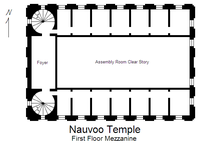 Access to the first floor mezzanine was directly from landings of the two staircases in the west end of the building. A foyer, corresponding in size to the vestibule below, connected the two stairway landings.
Access to the first floor mezzanine was directly from landings of the two staircases in the west end of the building. A foyer, corresponding in size to the vestibule below, connected the two stairway landings.
Evidence suggests that this mezzanine had fourteen small rooms, seven along each side of the North and South wall. Each room had a small circular window supplying light. These rooms may never have been completed, except perhaps some kind of partition dividing them.
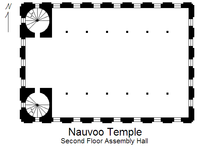 The second floor hall was similar in construction to the Great Hall, except that it included the foyer area where the vestibule would be. This made the room about seventeen feet longer. A 41 feet (12.5 m) stone arch ran north and south between the circular stairwells supporting the massive timbers for the tower above. It had seven large windows along the north and south wide, with four windows along the east wall.
The second floor hall was similar in construction to the Great Hall, except that it included the foyer area where the vestibule would be. This made the room about seventeen feet longer. A 41 feet (12.5 m) stone arch ran north and south between the circular stairwells supporting the massive timbers for the tower above. It had seven large windows along the north and south wide, with four windows along the east wall.
The floor would have a similar configuration as the Great Hall with a set of double pulpits and pews, but the room was never completed. Doors were never hung, the plastering was unfinished, and the floorboards were only rough timber, not the tongue and grove finished hardwoods of the other floors. The room, when used for an occasional meeting, was furnished with wooden benches.
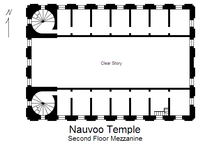 The second mezzanine was similar to the first floor mezzanine. It was accessed via the two staircases at the West end of the building. There was no foyer connecting the two stairwells.
The second mezzanine was similar to the first floor mezzanine. It was accessed via the two staircases at the West end of the building. There was no foyer connecting the two stairwells.
The second floor mezzanine is also presumed to have been divided into fourteen small rooms, seven rooms along each side of the North and South walls of the building, between the arched ceiling of the second floor. Circular windows in the entablature of the building allowed for illumination. Just as with the second floor assembly room, there is no evidence that these rooms were ever completed, except perhaps for the partitions dividing each room. There was a staircase in the second room from the Southeast corner leading to a room above, providing another access method to the attic.
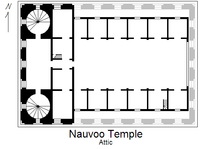 At the top of the two stairways, opening to a foyer, was the attic floor. The attic was not built of limestone but of wood. It was composed of two sections. The West end of the temple was a flat roofed section that supported the tower. The rest of the attic was a pitched-roof section running the length of the temple.
At the top of the two stairways, opening to a foyer, was the attic floor. The attic was not built of limestone but of wood. It was composed of two sections. The West end of the temple was a flat roofed section that supported the tower. The rest of the attic was a pitched-roof section running the length of the temple.
The flat-room section was further divided into two sections, the foyer on the west side, and a suite of rooms to the east. When the attic was used for ordinance work, they were used as a pantry, wardrobe and storage rooms. The area was illuminated by six windows along the foyer's west wall. Outside windows also provided light along the north and south sides. The roof had four octagonal skylight windows to provide light to the interior rooms, in addition to a twenty-foot arched window.
The incline of the roof prevented a six-foot-tall man from standing erect along the outside wall. The second room from the south-east corner had a stairway leading to a room in the mezzanine below.
Mormon
The term Mormon most commonly denotes an adherent, practitioner, follower, or constituent of Mormonism, which is the largest branch of the Latter Day Saint movement in restorationist Christianity...
s. The church's first temple
Kirtland Temple
The Kirtland Temple is a National Historic Landmark in Kirtland, Ohio, USA, on the eastern edge of the Cleveland metropolitan area. Owned and operated by the Community of Christ, formerly the Reorganized Church of Jesus Christ of Latter Day Saints , the house of worship was the first temple to be...
was completed in Kirtland, Ohio
Kirtland, Ohio
Kirtland is a city in Lake County, Ohio, USA. The population was 6,670 at the 2000 census. Kirtland is famous for being the early headquarters of the Latter Day Saint movement.-Origins of Kirtland:...
, United States
United States
The United States of America is a federal constitutional republic comprising fifty states and a federal district...
in 1836. When the main body of the church was forced out of Nauvoo, Illinois
Nauvoo, Illinois
Nauvoo is a small city in Hancock County, Illinois, United States. Although the population was just 1,063 at the 2000 census, and despite being difficult to reach due to its location in a remote corner of Illinois, Nauvoo attracts large numbers of visitors for its historic importance and its...
in the winter of 1846, the church attempted to sell the building, finally succeeding in 1848 . The building was damaged by fire and a tornado before being demolished.
In 1937, The Church of Jesus Christ of Latter-day Saints reacquired the lot on which the original temple had stood. The Church built a temple on the original site whose exterior is a replica of the first temple, but whose interior is laid out like a modern Latter-day Saint temple
Temple (LDS Church)
In The Church of Jesus Christ of Latter-day Saints , a temple is a building dedicated to be a House of the Lord, and they are considered by Church members to be the most sacred structures on earth. Upon completion, temples are usually open to the public for a short period of time...
. On 27 June 2002, this new temple was dedicated as the Nauvoo Illinois Temple
Nauvoo Illinois Temple
The Nauvoo Illinois Temple is the 113th dedicated temple of The Church of Jesus Christ of Latter-day Saints. It is the third such temple that has been built in Illinois ....
.
History

Nauvoo, Illinois
Nauvoo is a small city in Hancock County, Illinois, United States. Although the population was just 1,063 at the 2000 census, and despite being difficult to reach due to its location in a remote corner of Illinois, Nauvoo attracts large numbers of visitors for its historic importance and its...
in 1839. On 6 April 1841, the temple's cornerstone was laid under the direction of Joseph Smith, Jr., the church's restorer. Sidney Rigdon
Sidney Rigdon
Sidney Rigdon was a leader during the early history of the Latter Day Saint movement.-Baptist background:...
gave the principal oration. At its base the building was 128 feet (39 m) long and 88 feet (26.8 m) wide with a clock tower
Clock tower
A clock tower is a tower specifically built with one or more clock faces. Clock towers can be either freestanding or part of a church or municipal building such as a town hall. Some clock towers are not true clock towers having had their clock faces added to an already existing building...
and weather vane
Weather vane
A weather vane is an instrument for showing the direction of the wind. They are typically used as an architectural ornament to the highest point of a building....
reaching to a total height of 165 feet (50.3 m)—a 60% increase over the dimensions of the Kirtland Temple. Like Kirtland, the Nauvoo Temple contained two assembly halls, one on the first floor and one on the second, called the lower and upper courts. Both had classrooms and offices in the attic. Unlike Kirtland, the Nauvoo Temple had a full basement which housed a baptismal font. Because the Saints had to abandon Nauvoo, the building was not entirely completed. The basement with its font was finished, as were the first floor assembly hall and the attic. When these parts of the building were completed they were used for performing ordinances (basement and attic) or for worship services (first floor assembly hall).

William Weeks
William Weeks , was the first church architect of the Church of Jesus Christ of Latter Day Saints, and is best known as the architect of the Nauvoo Temple....
, under the direction of Smith. Weeks' design made use of distinctively Latter-day Saint motifs, including Sunstones, Moonstones, and Starstones. It is often mistakenly thought that these stones represent the Three Degrees of Glory
Degrees of glory
In The Church of Jesus Christ of Latter-day Saints' theology, there are three degrees of glory which are the ultimate, eternal dwelling place for nearly all who lived on earth after the Spirit world.Joseph Smith, Jr...
in the Mormon conception of the afterlife, but the stones appear in the wrong order. Instead, Wandle Mace, foreman for the framework of the Nauvoo Temple, has explained that the design of the temple was meant to be “a representation of the Church, the Bride, the Lamb’s wife” (Wandle Mace, Autobiography 207 (BYU Special Collections)). In this regard Mace references John’s statement in Revelation 12:1 concerning the “woman clothed with the sun, and the moon under her feet, and upon her head a crown of twelve stars.” This explains why the Starstones are at the top of the temple (“crown of twelve stars”), the Sunstones in the middle (“clothed with the sun”) and the Moonstones at the bottom (“moon under her feet”).
Construction was only half complete when Smith was assassinated in 1844. After a succession crisis
Succession crisis (Mormonism)
The succession crisis in the Latter Day Saint movement occurred after the violent death of the movement's founder, Joseph Smith, Jr., on June 27, 1844....
, Brigham Young
Brigham Young
Brigham Young was an American leader in the Latter Day Saint movement and a settler of the Western United States. He was the President of The Church of Jesus Christ of Latter-day Saints from 1847 until his death in 1877, he founded Salt Lake City, and he served as the first governor of the Utah...
was sustained as the church's leader by the majority of Mormons in Nauvoo. As mob violence increased during the summer of 1845, he encouraged the Latter-day Saints to complete the temple even as they prepared to abandon the city. Young likely altered the original plans to add a large pediment
Pediment
A pediment is a classical architectural element consisting of the triangular section found above the horizontal structure , typically supported by columns. The gable end of the pediment is surrounded by the cornice moulding...
beneath the cupola
Cupola
In architecture, a cupola is a small, most-often dome-like, structure on top of a building. Often used to provide a lookout or to admit light and air, it usually crowns a larger roof or dome....
. Even as the temple was under construction portions of it were used for sacred rites, such as baptisms for the dead
Baptism for the dead
Baptism for the dead, vicarious baptism or proxy baptism is the religious practice of baptizing a living person on behalf of one who is dead, with the living person acting as the deceased person's proxy...
in the basement font. During the winter of 1845-46, the temple began to be used for additional ordinances, including the Nauvoo-era rituals of Endowment
Endowment (Mormonism)
In Mormonism, the endowment is an ordinance designed to prepare participants to become kings, queens, priests, and priestesses in the afterlife. As part of the ceremony, participants take part in a scripted reenactment of the Biblical creation and fall of Adam and Eve...
and Sealings in Marriage and Adoptions
Law of adoption
The law of adoption was a ritual practiced in Latter Day Saint temples between 1846 and 1894 in which men who held the priesthood were sealed in a father–son relationship to other men who were not part of nor even distantly related to their immediate nuclear family.-Practice:Some younger men who...
. The Nauvoo Temple was in use for less than three months.
Most of the Latter-day Saints left Nauvoo, beginning in February 1846, but a small crew remained to finish the temple's first floor, so that it could be formally dedicated. Once the first floor was finished with pulpits and benches, the building was finally dedicated in private services on 30 April 1846, and in public services on 1 May. In September 1846 the remaining Mormons were driven from the city and vigilantes from the neighboring region, including Carthage, Illinois
Carthage, Illinois
Carthage is a city in Hancock County, Illinois, United States. The population was 2,725 at the 2000 census. It is the county seat of Hancock County. Carthage is most famous for being the site of the murder of Joseph Smith in 1844.- History :...
, entered the near-empty city and vandalized the temple.
.jpg)
Church of Jesus Christ of Latter Day Saints (Strangite)
The Church of Jesus Christ of Latter Day Saints is a denomination of the Latter Day Saint movement with around three hundred members as of 1998...
of Latter Day Saints, accused Young's agents of setting fire to the temple; however, these charges were never proven. On 2 April 1849 LeBaron sold the damaged temple to Étienne Cabet
Étienne Cabet
Étienne Cabet was a French philosopher and utopian socialist. He was the founder of the Icarian movement and led a group of emigrants to found a new society in the United States.-Biography:...
for $2000. Cabet, whose followers were called Icarians
Icarians
The Icarians were a French utopian movement, founded by Étienne Cabet, who led his followers to America where they established a group of egalitarian communes during the period from 1848 through 1898.-European roots:Étienne Cabet was born in France in 1788...
, hoped to establish Nauvoo as a communistic
Communism
Communism is a social, political and economic ideology that aims at the establishment of a classless, moneyless, revolutionary and stateless socialist society structured upon common ownership of the means of production...
utopia
Utopia
Utopia is an ideal community or society possessing a perfect socio-politico-legal system. The word was imported from Greek by Sir Thomas More for his 1516 book Utopia, describing a fictional island in the Atlantic Ocean. The term has been used to describe both intentional communities that attempt...
.
Destruction

Hancock County, Illinois
Hancock County is a county located in the U.S. state of Illinois. According to the 2010 census, it has a population of 19,104, which is a decrease of 5.1% from 20,121 in 2000. Its county seat is Carthage. Hamilton is the largest city in Hancock County, with Carthage being the second largest...
. In February 1865 Nauvoo's City Council ordered the final demolition of the last standing portion of the temple—one lone corner of the façade. Soon afterwards, all evidence of the temple disappeared, except for a hand pump over a well that supplied water to the font. Three of the original sunstones are known to have survived and are on display — one is on loan to The Church of Jesus Christ of Latter-day Saints' Visitor Center in Nauvoo, one is in the Smithsonian Institution
Smithsonian Institution
The Smithsonian Institution is an educational and research institute and associated museum complex, administered and funded by the government of the United States and by funds from its endowment, contributions, and profits from its retail operations, concessions, licensing activities, and magazines...
in Washington, D.C, and the third and only one that has not been restored is displayed, along with the only moonstone on display, at the Joseph Smith Historic Center (Community of Christ
Community of Christ
The Community of Christ, known from 1872 to 2001 as the Reorganized Church of Jesus Christ of Latter Day Saints , is an American-based international Christian church established in April 1830 that claims as its mission "to proclaim Jesus Christ and promote communities of joy, hope, love, and peace"...
).
Nauvoo Illinois Temple

Gordon B. Hinckley
Gordon Bitner Hinckley was an American religious leader and author who served as the 15th President of The Church of Jesus Christ of Latter-day Saints from March 12, 1995 until his death...
announced the rebuilding of the temple on its original footprint. After two years of construction, on 27 June 2002, the church dedicated the new temple
Nauvoo Illinois Temple
The Nauvoo Illinois Temple is the 113th dedicated temple of The Church of Jesus Christ of Latter-day Saints. It is the third such temple that has been built in Illinois ....
, whose exterior is a replica of the first temple, but whose interior is laid out like a modern Latter-day Saint temple
Temple (LDS Church)
In The Church of Jesus Christ of Latter-day Saints , a temple is a building dedicated to be a House of the Lord, and they are considered by Church members to be the most sacred structures on earth. Upon completion, temples are usually open to the public for a short period of time...
.
Architecture
At its base the Nauvoo Temple was 128 feet (39 m) long and 88 feet (26.8 m) wide with a tower and weather vane reaching to 65 feet (19.8 m). The second temple of the Latter Day Saint movementLatter Day Saint movement
The Latter Day Saint movement is a group of independent churches tracing their origin to a Christian primitivist movement founded by Joseph Smith, Jr. in the late 1820s. Collectively, these churches have over 14 million members...
was built 60% larger in dimensions than its predecessor, the Kirtland Temple. Like Kirtland, the temple contained two assembly halls, one on the first floor and one on the second, called the lower and upper courts. Both had classrooms and offices in the attic. Unlike Kirtland
Kirtland Temple
The Kirtland Temple is a National Historic Landmark in Kirtland, Ohio, USA, on the eastern edge of the Cleveland metropolitan area. Owned and operated by the Community of Christ, formerly the Reorganized Church of Jesus Christ of Latter Day Saints , the house of worship was the first temple to be...
, it had a full basement which housed a baptismal font.
Exterior
The exterior finish, like most of the temple, was made of limestoneLimestone
Limestone is a sedimentary rock composed largely of the minerals calcite and aragonite, which are different crystal forms of calcium carbonate . Many limestones are composed from skeletal fragments of marine organisms such as coral or foraminifera....
, quarried from a site just west of the temple.
Basement

Baptismal font
A baptismal font is an article of church furniture or a fixture used for the baptism of children and adults.-Aspersion and affusion fonts:...
in the center of the main room.
The basement was reached from the spiral staircases at the Northwest and Northeast corners of the temple. The staircase landing was made of wood and opened to a short hallway heading East, leading to the basement proper. Between the two hallways was an unfinished room sealed off from the rest of the temple, containing an old well that had been dug but never used. The room was discovered by an anti-Mormon mob who broke through the floor of the vestibule above.
The basement proper was one hundred feet long and forty feet wide with six rooms of varying sized on either side. The sides of the rooms were stone and abutted the massive stone piers that supported the floors above. With the exception of the two rooms at the West end of the basement, reportedly used for clerical purposes, each side room rose two steps in height from the basement floor. The rooms were dressing rooms for those using the font. The floor was made of red brick laid in a herringbone pattern. The walls were painted white. The floor sloped down to the center of the room to allow water to run toward a drain beneath the font.
During an archaeological investigation of the temple site, two highly polished limestone blocks were discovered.
Approximately twelve feet east of the entrance to the baptistry and ten feet from either the side of the support piers rested the blocks, roughly fourteen inches square, which projected seven inches (178 mm) above the brick floor. These objects are not mentioned in any account of the basement, and their purpose is unknown. They may have held some type of support columns, dividing the font from the entrance to the basement or they may have simply been a decorative element with a vase or something similar resting on them. They may have been part of a feature planned, but not used, in the final construction.
The baptismal font
Every visitor who wrote about the temple mentioned the baptismal font. It was clearly the most impressive feature of the temple. There were actually two fonts built during the lifetime of the temple, a temporary wooden one, and a permanent limestone one.The first font was built out of tongue and groove
Tongue and groove
A strong joint, the tongue and groove joint is widely used for re-entrant angles. The effect of wood shrinkage is concealed when the joint is beaded or otherwise moulded...
d white pine and painted white. It was sixteen feet long, twelve feet wide and four feet deep. The lip of the font was seven feet from the floor. The font's cap and base were carved molding in an "antique style" and the sides were finished with panel work. Two railed stairways led to the font from the north and south sides.
The font was held up by twelve oxen as are all Latter-day Saint temple fonts. They were carved from pine planking that was glued together. They were patterned from the most beautiful five-year old steer that could be found in the region. The head, shoulders and legs protruded beyond the base of the font, and they appeared to have sunk to their knees into the pavement. The most perfect horn that could be found was used to model the animals horns.
A decision was made to replace the wooden font in 1845, apparently because the water caused a mildew odor, and possibly because the wood began to rot. The new limestone font followed the pattern of the wooden one. Twelve oxen held up the basin, four on each side and two at each end. The oxen were solid stone and similarly were placed and appeared sunken into the floor. Where the oxen met the basin, the stone was carved to suggest drapery. The ears of the oxen were made of tin. The stairs were moved to an East/West orientation making access to the font easier.
A well on the east side of the font provided the water supply. There may have been some kind of tank at the East end of the baptistry to store and heat water.
The vestibule

The archways were approximately nine feet wide and twenty-one feet high.
The vestibule itself was forty-three feet by seventeen feet in dimension. It was composed of limestone on all four of its walls. The floor has been speculated to be made of wood, because when the mob occupied the temple briefly in late 1847, they broke through the floor to reach a sealed off room in the basement. Had the floor been limestone, it seems unlikely that they would have dug it up.
Two large double doors on the east wall opened to the first floor assembly hall of the lower court, known as the "Great Hall". Two doors, one on the North wall, and another on the South opened to the landing of two spiral staircases, one in the Northwest corner, and the other in the Southwest corner which led all the way to the attic. These were the only access points to the rest of the building.
One report stated that on the east wall of the vestibule was an entablature, similar to the one in the facade, which read in bright gilded letters, "THE HOUSE OF THE LORD - Built by The Church of Jesus Christ of Latter-Day Saints - Commenced April 6th, 1841 - HOLINESS TO THE LORD."
The stairwells
The two stairwells were constructed of dressed limestone walls. One rose from Northwest corner and the other at the Southwest corner of the temple. They were not true circles but were flatted on four sides. Nor were they symmetrical, being sixteen feet in diameter from East to West and seventeen feet in diameter from North to South. This was done to support landings and other support structures.The staircases, made of wood, provided access to all of the temple from the basement to the attic with a landing at each floor. They had lamps for illumination at night, and had windows for daytime illumination. William Weeks' elevation of the front facade does not show windows at the basement level of the two stairwells, and photographic evidence is inconclusive. However, Joseph Smith's youngest son, David Smith, rendered a painting of the temple's damaged facade, clearly shows half-circular windows at the basement level in the north and south corners of the facade.
The staircase in the northwest corner was never completed. It was roughed in with temporary boards resting on the risers. Workmen used this staircase to gain access to the building during its construction, especially during the winter of 1845-1846 when persons were using the other staircase to reach the attic for ordinance work. The southwest staircase was completely finished for use. It included lamps for night illumination, and may have been carpeted near the attic landing.
The Great Hall
Entrance to the first floor assembly hall, called the "Great Hall", was through two large double doors at the east end of the vestibule. The Great Hall occupied the remainder of the floor space East of the vestibule. The room was flanked on either side by seven large, arched windows, with four similar windows along the east wall. An arched ceiling spanned some fifty feet in breadth, in the center. the floor was stained wood and the walls were painted white.There were two rooms to the north just past the entrance. It has been suggested that these rooms were used initially by William Weeks
William Weeks
William Weeks , was the first church architect of the Church of Jesus Christ of Latter Day Saints, and is best known as the architect of the Nauvoo Temple....
, because they are referred by Thomas Bullock
Thomas Bullock (Mormon)
Thomas Bullock was a Mormon pioneer and a clerk in the Church Historian's Office of The Church of Jesus Christ of Latter-day Saints.Bullock was born in Leek, Staffordshire, England...
as the "architect's room." Their eventual intended use is not clear.
Pulpits
At the East and West ends of the hall were two sets of similar pulpits. Resembling the pulpits used in the Kirtland Temple, and repeated in later temples, they were arranged with four levels, the top three consisting of a group of three semi-circular stands. The lowest level was a drop-table which was raised for use in the sacramentSacrament (Mormonism)
In The Church of Jesus Christ of Latter-day Saints , the Holy Sacrament of the Lord's Supper, most often simply referred to as the sacrament, is the sacrament in which participants partake of bread and drink water in remembrance of the body and blood of Jesus Christ...
.
The pulpits to the East, standing between the windows, were reserved for the Melchezidek Priesthood. Accordingly each pulpit had initials identifying the priesthood office of the occupant. The top most pulpits read P.H.P., which stood for President of the High Priesthood. The next level down had P.S.Q for President of the Seventy Quorums. Below that, the labels were P.H.Q. which stood for President of the High priests Quorum, and the folding table had the inscription P.E.Q. standing for President of the Elders Quorum.
Above the Eastern pulpits, written in gilded letters, along the arch of the ceiling, were the words,"The Lord Has Seen Our Sacrifice - Come After Us."
The pulpits to the West end were reserved for the Aaronic Priesthood. Each pulpit similarly had initials identifying the priesthood officers who occupied that stand. The highest three pulpits bore the initials P.A.P., which stood for President of the Aaronic Priesthood. The next lower pulpits had P.P.Q., for President of the Priests Quorum). Again, the next had P.T.Q. for President of the Teachers Quorum and on the table at the bottom was written P.D.Q. for President of the Deacons Quorum.
Pews
Similar to the Kirtland Temple, the hall was fitted with enclosed pews with two aisles running down its length. There were also pews for a band and choir. The room could accommodate up to 3,500 people. Because there were pulpits on both ends of the room, the pews had movable backs which could be swung to face either direction, depending on who was presiding - the Melchizedek Priesthood or the Aaronic Priesthood.First floor mezzanine

Evidence suggests that this mezzanine had fourteen small rooms, seven along each side of the North and South wall. Each room had a small circular window supplying light. These rooms may never have been completed, except perhaps some kind of partition dividing them.
Second floor assembly hall

The floor would have a similar configuration as the Great Hall with a set of double pulpits and pews, but the room was never completed. Doors were never hung, the plastering was unfinished, and the floorboards were only rough timber, not the tongue and grove finished hardwoods of the other floors. The room, when used for an occasional meeting, was furnished with wooden benches.
Second floor mezzanine rooms

The second floor mezzanine is also presumed to have been divided into fourteen small rooms, seven rooms along each side of the North and South walls of the building, between the arched ceiling of the second floor. Circular windows in the entablature of the building allowed for illumination. Just as with the second floor assembly room, there is no evidence that these rooms were ever completed, except perhaps for the partitions dividing each room. There was a staircase in the second room from the Southeast corner leading to a room above, providing another access method to the attic.
Attic

The flat-room section was further divided into two sections, the foyer on the west side, and a suite of rooms to the east. When the attic was used for ordinance work, they were used as a pantry, wardrobe and storage rooms. The area was illuminated by six windows along the foyer's west wall. Outside windows also provided light along the north and south sides. The roof had four octagonal skylight windows to provide light to the interior rooms, in addition to a twenty-foot arched window.
The incline of the roof prevented a six-foot-tall man from standing erect along the outside wall. The second room from the south-east corner had a stairway leading to a room in the mezzanine below.
Tower rooms
Rising from the plateau of the attic is an octagonal tower. The tower was divided into three sections, each accessible by a series of stairways leading from the attic to an observation deck at the top. The lowest section was the belfry. The bell was rung for various occasions. Between the observation deck and the belfry was a section containing the four clockwork mechanisms.See also
- Comparison of temples of The Church of Jesus Christ of Latter-day SaintsComparison of temples of The Church of Jesus Christ of Latter-day SaintsBelow is a chronological list of temples of The Church of Jesus Christ of Latter-day Saints with sortable columns. In The Church of Jesus Christ of Latter-day Saints, a temple is a building dedicated to be a House of the Lord, and considered by church members to be the most sacred structures on earth...
- Joseph TorontoJoseph Toronto-Biography:Toronto was born in Sardinia and was a sailor in the Mediterranean Merchant Marines and on trans-Atlantic freighters. While in Boston, Massachusetts in 1843, Toronto met Latter Day Saint missionaries, read the Book of Mormon , and was baptized by George B...
- List of temples of The Church of Jesus Christ of Latter-day Saints
- List of temples of The Church of Jesus Christ of Latter-day Saints by geographic region
- Temple architecture (Latter-day Saints)
External links
- Nauvoo Temple - History of the Nauvoo Temple

